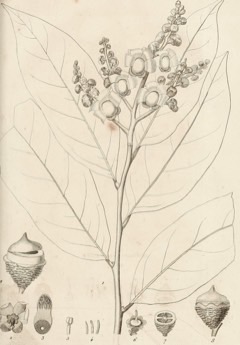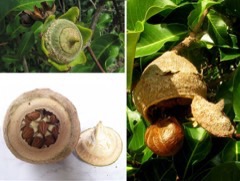 |
|
edibleplants.org |
 |
| Lecythis fruit, a "pot" fruit. |
Translate this page:
Summary
Physical Characteristics

 Lecythis corrugata is an evergreen Tree growing to 25 m (82ft) by 20 m (65ft) at a medium rate.
Lecythis corrugata is an evergreen Tree growing to 25 m (82ft) by 20 m (65ft) at a medium rate.
See above for USDA hardiness. It is hardy to UK zone 10. The flowers are pollinated by Bees, insects.
Suitable for: light (sandy), medium (loamy) and heavy (clay) soils and prefers well-drained soil. Suitable pH: mildly acid, neutral and basic (mildly alkaline) soils. It cannot grow in the shade. It prefers moist soil.
UK Hardiness Map
US Hardiness Map
Synonyms
Bertholletia minor Choisy ex R.Knuth Chytroma basilaris Miers Chytroma corrugata (Poit.) R.Knuth Chytroma rosea (Spruce ex O.Berg) Miers Chytroma rubiflora Miers Chytroma salebrosa (O.Berg) Miers Eschweilera conduplicata A.C.Sm. Eschweilera corrugata (Poit.) Miers Eschweilera jenmanii R.Knuth Eschweilera patrisii R.Knuth Eschweilera salebrosa (O.Berg) Nied. Lecythis cognata Miers Lecythis martini O.Berg Lecythis rosea Spruce ex O.Berg Lecythis rubicunda Miers Lecythis salebrosa O.Berg Lecythis venusta Miers
Plant Habitats
Edible Uses
Edible Parts: Oil
Edible Uses: Oil
Staple Crop Protein-Oil
References More on Edible Uses
Medicinal Uses
Plants For A Future can not take any responsibility for any adverse effects from the use of plants. Always seek advice from a professional before using a plant medicinally.
An infusion of the bark is used to treat diarrhoea[348 ]. A decoction of the bark is poured onto cuts in order to accelerate the healing process[348 ].
References More on Medicinal Uses
The Bookshop: Edible Plant Books
Our Latest books on Perennial Plants For Food Forests and Permaculture Gardens in paperback or digital formats.

Edible Tropical Plants
Food Forest Plants for Hotter Conditions: 250+ Plants For Tropical Food Forests & Permaculture Gardens.
More

Edible Temperate Plants
Plants for Your Food Forest: 500 Plants for Temperate Food Forests & Permaculture Gardens.
More

More Books
PFAF have eight books available in paperback and digital formats. Browse the shop for more information.
Shop Now
Other Uses
Oil
The inner bark is long and stiingy like that of the Lime-tree (Tilia spp.)[492 ]. The inner bark of the lime is a source of fibre - is this bark used similarly?[K ]. The heartwood is a reddish or greyish-brown; it is not clearly demarcated from the 4cm wide band of light brown sapwood. The grain is fine and dense, the wood cold and smooth to the touch with a peculiar smell when worked, but no discernible taste when seasoned. It is heavy; hard, becoming harder with age; exceedingly strong and hard to break transversely; durable to very durable. There are differing reports on its ability to resist the attacks of toredo and barnacles[492 ]. It is widely recognized for its high resistance to marine borers[960 ]. The wood is very hard to saw and plane; it is fissile, taking nails badly; it turns and polishes indifferently, except in the best qualities; it cleaves straight. The wood is not very ornamental, but can be used for house-framing, wharves and sluices[492 ].
Special Uses
Carbon Farming
References More on Other Uses
Cultivation details
Management: Standard Regional Crop Staple Crop: Protein-oil
Tropical and humid
Carbon Farming
-
Management: Standard
Plants grow to their standard height. Harvest fruit, seeds, or other products. Non-Destructive management systems.
-
Regional Crop
These crops have been domesticated and cultivated regionally but have not been adopted elsewhere and are typically not traded globally, Examples in this broad category include perennial cottons and many nuts and staple fruits.
-
Staple Crop: Protein-oil
(16+ percent protein, 16+ percent oil). Annuals include soybeans, peanuts, sunflower seeds. Perennials include seeds, beans, nuts, and fruits such as almond, Brazil nut, pistachio, walnut, hazel, and safou.
References Carbon Farming Information and Carbon Sequestration Information
Temperature Converter
Type a value in the Celsius field to convert the value to Fahrenheit:
Fahrenheit:
The PFAF Bookshop
Plants For A Future have a number of books available in paperback and digital form. Book titles include Edible Plants, Edible Perennials, Edible Trees,Edible Shrubs, Woodland Gardening, and Temperate Food Forest Plants. Our new book is Food Forest Plants For Hotter Conditions (Tropical and Sub-Tropical).
Shop Now
Plant Propagation
Seed
Other Names
If available other names are mentioned here
Mahot rouge, Guacharaco
Native Range
SOUTHERN AMERICA: French Guiana, Guyana, Suriname, Venezuela (Amazonas, Apure, Bolívar, Delta Amacuro, Mérida, Táchira, Zulia), Brazil (Pará, Amapá, Roraima)
Weed Potential
Right plant wrong place. We are currently updating this section.
Please note that a plant may be invasive in one area but may not in your area so it's worth checking.
None Known
Conservation Status
IUCN Red List of Threatened Plants Status : This taxon has not yet been assessed

Growth: S = slow M = medium F = fast. Soil: L = light (sandy) M = medium H = heavy (clay). pH: A = acid N = neutral B = basic (alkaline). Shade: F = full shade S = semi-shade N = no shade. Moisture: D = dry M = Moist We = wet Wa = water.
Now available:
Food Forest Plants for Mediterranean Conditions
350+ Perennial Plants For Mediterranean and Drier Food Forests and Permaculture Gardens.
[Paperback and eBook]
This is the third in Plants For A Future's series of plant guides for food forests tailored to
specific climate zones. Following volumes on temperate and tropical ecosystems, this book focuses
on species suited to Mediterranean conditions—regions with hot, dry summers and cool, wet winters,
often facing the added challenge of climate change.
Read More
Expert comment
Author
Poit.
Botanical References
Links / References
For a list of references used on this page please go here
A special thanks to Ken Fern for some of the information used on this page.
Readers comment
| Add a comment |
|
If you have important information about this plant that may help other users please add a comment or link below. Only comments or links that are felt to be directly relevant to a plant will be included. If you think a comment/link or information contained on this page is inaccurate or misleading we would welcome your feedback at [email protected]. If you have questions about a plant please use the Forum on this website as we do not have the resources to answer questions ourselves.
* Please note: the comments by website users are not necessarily those held by PFAF and may give misleading or inaccurate information.
To leave a comment please Register or login here All comments need to be approved so will not appear immediately.
|
Subject : Lecythis corrugata
|
|
|
|